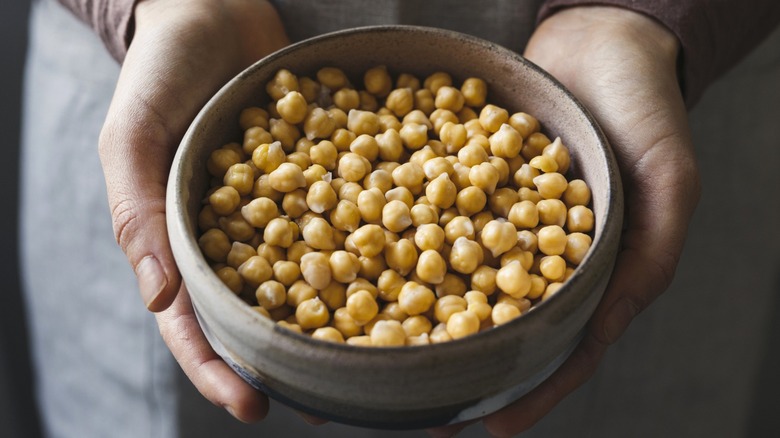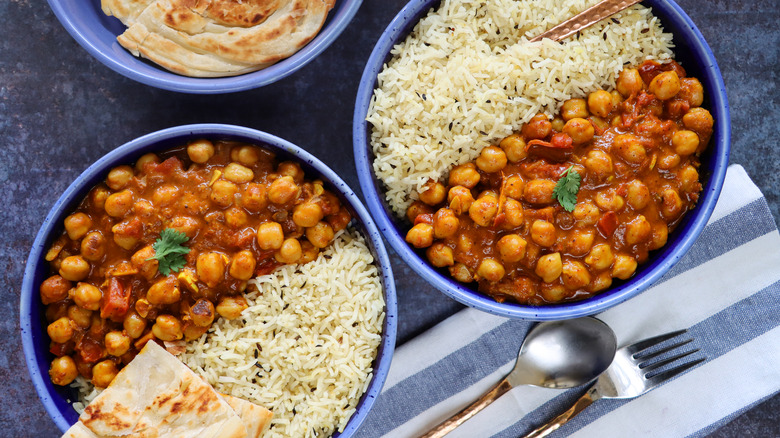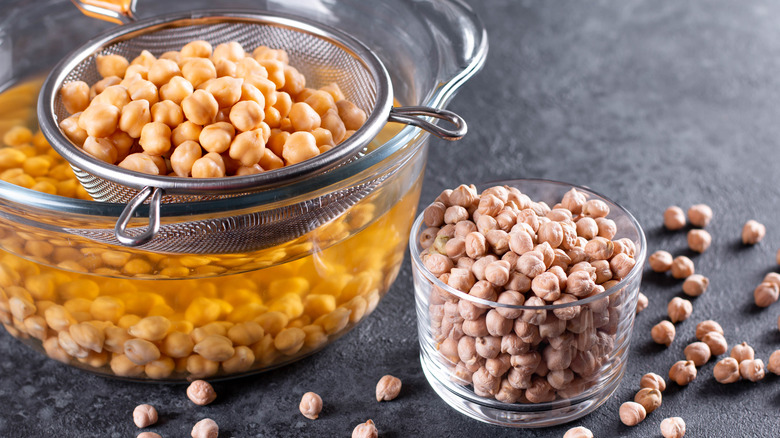The Reason Chickpeas Are Also Called Garbanzo Beans
The first thing we need to clear up is the difference between chickpeas and garbanzo beans. The difference is that ... there is no difference! Despite the two names, chickpeas and garbanzos are the same exact thing. The plant's scientific name, Cicer arietinum, provides a clue as to how this one bean ended up with two names. And yes, it's a bean, not a pea.
Cicer is the Latin word for chickpea. Originating in the region of Turkey and Syria, the polyonymous bean took root in the cuisines of the Middle East, Greece, France, India, and Africa — eventually becoming a worldwide staple. From cicer came the French name pois chiche, which, in England, was translated to chich-pease, and finally settled in the English language as chickpea.
So how did we get from there to also calling it a garbanzo bean? By way of Spain, Latin America, and Mexico. Garbanzo is the Spanish word for chickpea, a variant of garavance. The name chickpea is widely used throughout the world, and garbanzo is more common in Spanish-speaking countries, as well as on the West Coast of the United States. In Southern California, there's even a neighborhood called Garvanza, so named for the wild beans that grew there, originally planted in the 19th century by its Mexican landowner. Regardless of what you call them and whether you buy a can of garbanzo beans in Los Angeles or a bag of dried chickpeas in Delhi, they are one and the same.
Different varieties of garbanzo beans are all still chickpeas
Further complicating things, there's more than one variety of chickpea — or garbanzo beans if you prefer. The two main types are called kabuli and desi. The kabuli variety is what most people in the West will be familiar with, as they are the kind you'll find canned at the supermarket. These are plump, light in color, and have thin, edible skin. They are what you would use for your best basic hummus recipe, for making falafel or tossing into salads.
Desi chickpeas, on the other hand, have a darker color that ranges from green to black, and a thick shell that needs to be hulled before cooking. Both varieties are used in Indian curry dishes like chana masala and Punjabi chole — in Hindi, both chana and chole are two more names for chickpea.
Either variety can be used to make flour, which also goes by multiple names. When made from kabuli beans, it's just called chickpea flour. When made from desi beans, the result is called gram flour, or besan. It's used to make a rustic flatbread that the French call socca and the Italians call farinata, and in India, it's used for pakoras (fritters), eggless omelets, savory pancakes, along with many snacks and desserts. All garbanzo beans are gluten-free, and by extension, so is chickpea flour.
This versatile bean answers to many names
Chickpeas can be purchased dried or canned. The dried beans require soaking before cooking — while they can be eaten or used as-is straight from the can. Many of the packaged beans available are labeled as both chickpeas and garbanzo beans, perhaps in an attempt by brands to avoid confusing people. It helps when shopping for recipe ingredients to know that chickpeas and garbanzo beans can be used interchangeably.
The nutty and creamy beans are prized not only for their delicious flavor but also for their nutritional benefits. They are a good source of vitamins, minerals, and fiber, as well as being high in vegetarian plant-based protein.
To add yet another garbanzo bean-related word to your vocabulary, try aquafaba on for size. This chickpea water egg substitute makes a fantastic vegan stand-in for eggs, especially in preparations such as meringues, macarons, marshmallows, and mayo. To make it, you simply drain the liquid from a can of garbanzos, then whip it until pillowy and fluffy.



